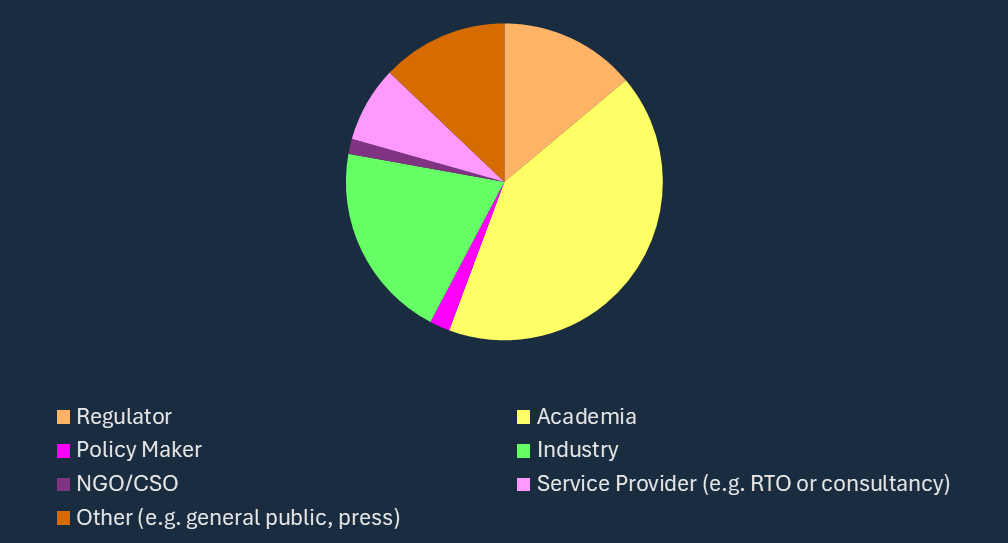The 2nd Joint online Workshop on ‘Harmonisation & Standardisation of Test Methods for Nanomaterials and Advanced Materials’, hosted by the four sister projects MACRAMÉ, iCare, nanoPASS and ACCORDs in collaboration with the Malta Initiative, was a fully success; nearly 200 experts with background ranging from regulatory and policy-making (16%), NGOs/CSOs (2%) academia (42%), to industry (20%), service providers (8%) and other origins (13%) followed the two day workshop.

The two workshop days focussed on next generation risk assessment, computational methods and the assessment of complex samples along the life cycle:
Day 1 – Next generation risk assessment – Challenges of its applicability for AdMas
The first day of the workshop highlighted the efforts in the development and standardisation of test methods for nanomaterials and advanced materials, with a view to the specific challenges posed by these materials that are often novel and innovative to the field of industrial materials.
The invited speakers outlined the area of discussion with presentations on the following topics:
- Needs Assessment of Regulatory and Policy Frameworks for Advanced Materials (Eric Bleeker, RIVM (Netherlands))
- Roadmap on phasing out animal testing – towards a future chemicals safety assessment (Elisabet Berggren, JRC (European Commission))
- Towards an overarching NGRA framework (PARC) (Matthias Herzler, BfR (Germany))
- Activities in PARC on Nanomaterials (Iseult Lynch, Uni Birmingham (United Kingdom))
- Challenges and steps of validating NAMs (Updating OECD Guidance Document 34) (Joao Barroso, JRC (European Commission))
- How to cover tox. endpoints without animal testing? (Robert Landsiedel , BASF (Germany))
- The Bridging Model C. elegans as a NAMs Tool in Neuronanosafety: Updates from iCare (Nivedita Chatterjee, INL (Portugal))
A round-table discussion at the end of Day 1 involved the participants in a conversation on the development and validation of new methods for assessing the safety of nanomaterials and advanced materials, the importance of collaboration between developers and validators, and the potential of public-private partnerships for the funding of validation efforts.
To watch the full recording of Day 1, follow this link (opens as a ZOOM clip).
Day 2 – A) Standardising testing along the life-cycle of advanced material-enabled products for risk assessment
The second day of the online workshop commenced with a session on the standardisation of testing and regulatory compliance for nanomaterials and advanced materials throughout their lifecycle, discussing challenges in characterization, risk assessment, and regulatory frameworks. Presentations covered topics such as release testing, automated microscopy, long-term hazard assessment, and the application of Omics and machine learning in toxicity prediction:
- Guidance on release testing of nanomaterials (Anna Pohl, BAuA (Germany))
- Experience from the assessment of graphene in cementitious and rubber based composites (Stephen Hodge, Versarien (United Kingdom))
- Regulatory Compliance: Progress and Hurdles (Kai B. Paul, Blue Frog Scientific Group (United Kingdom))
During a Q&A- and discussion round of the session, the speakers agreed that while there are difficulties, they were working together to balance industry and regulatory needs in the development of advanced materials.
[There is a] need for better communication between industry, regulators, and NGOs to avoid portraying industry as always trying to avoid regulation.
[Discussion session during the 2nd joint online Workshop: Harmonisation & Standardisation of Test Methods for Nano- and Advanced Materials]
The possibility of public-private partnerships to address non-regulatory issues was suggested and the need for long-term funding for such projects and the importance of coordination and setting priorities was stressed. The conversation also touched on the need for better communication between industry, regulators, and NGOs to avoid portraying industry as always trying to avoid regulation.
Day 2 – B) Essential use of advanced computational methods to support risk assessment of nano and advanced materials
The second part of Day 2 was led by presentations on new method for automated correlative microscopy of advanced materials, which could help in identifying and classifying objects with respect to their identity, morphology, and hazard characteristics, on automatic time evolved microscopy for imaging materials, and on the challenges of the satndardisation of data and the incorporation of digital models into regulatory decision making:
- Advanced computational methods for automated correlative microscopy of AdMas (Asmus Meyer-Plath, BAuA (Germany))
- Challenges in Correlative imaging of Advanced Materials (Dan Hodoroaba, BAM (Germany))
- Automated time-evolved microscopy, automated image quantification and automated in-vitro-to-in-silico translation for High-throughput Mode-of-Action determination and associated long-term Hazard assessment (Janez Štrancar, Infinite Biotech (Slovenia))
- The use of modelling in OMICs and how to use OMICs for regulation (Roland Grafström, Karolinsk Institut (Sweden))
- Standardisation challenges for AI-ready and trustworthy (meta)data provision (Thomas Exner, 7P9 (Germany))
To watch the full redording of Day 2, follow this link (opens as a ZOOM clip).
The speakers presentations can be viewed on the dedicated webpage of the 2nd Joint online Workshop on ‘Harmonisation & Standardisation of Test Methods for Nanomaterials and Advanced Materials’.




